简介
Netty是一个基于异步和事件驱动的开源网络框架,帮助开发者快速的实现高效能和可扩展的客户端/服务器端应用程序。 它广泛应用于各大互联网企业。github地址:https://github.com/netty/netty
Netty主要特征
- 简单而强大的线程模型
- 多种传输模型统一接口
- 比原始Java网络API简单易用
- 健壮,安全
- 减少内存拷贝,吞吐量高,延迟低
- 强大的社区支持
Netty组件图(来源于)Netty官网
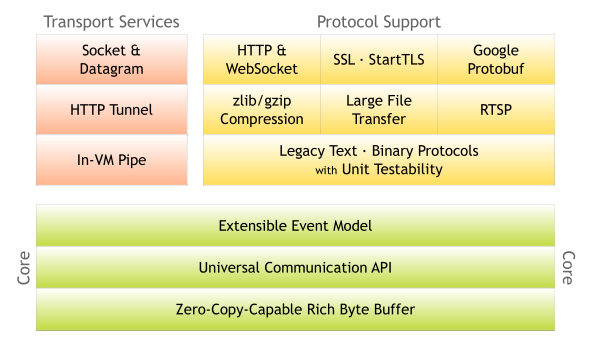
Netty Echo Demo
Demo简介
Echo(回声)案例,将客户端发送的字符串原样返回,此应用很简单,为了理解请求-响应交互本身。
服务器端
基于Netty的应用需要以下两个部分:
- 服务器
Handler,Handler组件用来实现服务器端业务逻辑,对消息进行处理 - 基于
ServerBootstrap引导服务器端启动代码。
例子来源于官方Demo
@Sharable
public class EchoServerHandler extends ChannelInboundHandlerAdapter {
@Override
public void channelRead(ChannelHandlerContext ctx, Object msg) {
ctx.write(msg);
}
@Override
public void channelReadComplete(ChannelHandlerContext ctx) {
ctx.flush();
}
@Override
public void exceptionCaught(ChannelHandlerContext ctx, Throwable cause) {
// Close the connection when an exception is raised.
cause.printStackTrace();
ctx.close();
}
}
EchoServerHandler#channelRead()将接收到的信息直接写入。
EchoServerHandler#channelReadComplete()刷新缓冲区。
EchoServerHandler#exceptionCaught()当异常发生后,关闭上下文。
引导服务器
public final class EchoServer {
static final boolean SSL = System.getProperty("ssl") != null;
static final int PORT = Integer.parseInt(System.getProperty("port", "8007"));
public static void main(String[] args) throws Exception {
// Configure SSL.
final SslContext sslCtx;
if (SSL) {
SelfSignedCertificate ssc = new SelfSignedCertificate();
sslCtx = SslContextBuilder.forServer(ssc.certificate(), ssc.privateKey()).build();
} else {
sslCtx = null;
}
// Configure the server.
EventLoopGroup bossGroup = new NioEventLoopGroup(1);
EventLoopGroup workerGroup = new NioEventLoopGroup();
try {
ServerBootstrap b = new ServerBootstrap();
b.group(bossGroup, workerGroup)
.channel(NioServerSocketChannel.class)
.option(ChannelOption.SO_BACKLOG, 100)
.handler(new LoggingHandler(LogLevel.INFO))
.childHandler(new ChannelInitializer<SocketChannel>() {
@Override
public void initChannel(SocketChannel ch) throws Exception {
ChannelPipeline p = ch.pipeline();
if (sslCtx != null) {
p.addLast(sslCtx.newHandler(ch.alloc()));
}
//p.addLast(new LoggingHandler(LogLevel.INFO));
p.addLast(new EchoServerHandler());
}
});
// Start the server.
ChannelFuture f = b.bind(PORT).sync();
// Wait until the server socket is closed.
f.channel().closeFuture().sync();
} finally {
// Shut down all event loops to terminate all threads.
bossGroup.shutdownGracefully();
workerGroup.shutdownGracefully();
}
}
}
EchoServer基于异步事件监听8007端口,基于EchoServerHandler处理客户端请求,类和方法的作用将在后续文章介绍。
为了更有效的观察和分析Netty的处理流程,在应用中配置log4j日志。
log4j.rootLogger=DEBUG,Console,File
log4j.appender.Console=org.apache.log4j.ConsoleAppender
log4j.appender.Console.Target=System.out
log4j.appender.Console.layout=org.apache.log4j.PatternLayout
log4j.appender.Console.layout.ConversionPattern=[%d{yyyy-MM-dd HH\:mm\:ss}] [%t] [%p] [%c{2}.%M:%L] %m%n
log4j.appender.File=org.apache.log4j.DailyRollingFileAppender
log4j.appender.File.DatePattern='.'yyyy-MM-dd
log4j.appender.File.Append=true
log4j.appender.File.File=logs/netty.log
log4j.appender.File.Threshold=INFO
log4j.appender.File.layout=org.apache.log4j.PatternLayout
log4j.appender.File.layout.ConversionPattern=[%d{yyyy-MM-dd HH\:mm\:ss}] [%t] [%p] [%c{2}.%M:%L] %m%n
运行EchoServer#main()
[2017-03-06 16:32:29] [main] [DEBUG] [logging.InternalLoggerFactory.debug:71] Using SLF4J as the default logging framework
[2017-03-06 16:32:29] [main] [DEBUG] [channel.MultithreadEventLoopGroup.debug:76] -Dio.netty.eventLoopThreads: 8
...
[2017-03-06 16:32:30] [nioEventLoopGroup-2-1] [INFO] [logging.LoggingHandler.info:101] [id: 0x353e3e66] BIND: 0.0.0.0/0.0.0.0:8007
[2017-03-06 16:32:30] [nioEventLoopGroup-2-1] [INFO] [logging.LoggingHandler.info:101] [id: 0x353e3e66, L:/0:0:0:0:0:0:0:0:8007] ACTIVE
处理客户端请求的NioEventLoopGroup的线程数为8,即当前可用CPU数量的2倍,绑定8007端口。
测试
telnet 8007端口
> telnet localhost 8087
基于JMeter的性能测试
JMeter是一个开源的Java性能测试软件,它支持对多种协议的测试,如HTTP, TCP,FTP等。
根据需求,建立测试计划,如:
添加 ‘Thread Group’
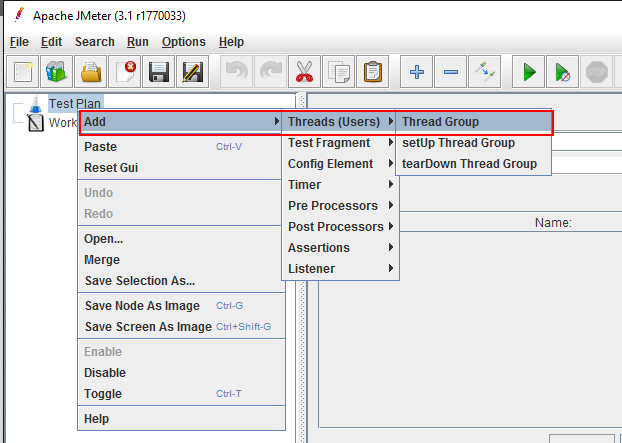

线程数代表模拟的用户数。
添加 ‘Logic Controller’
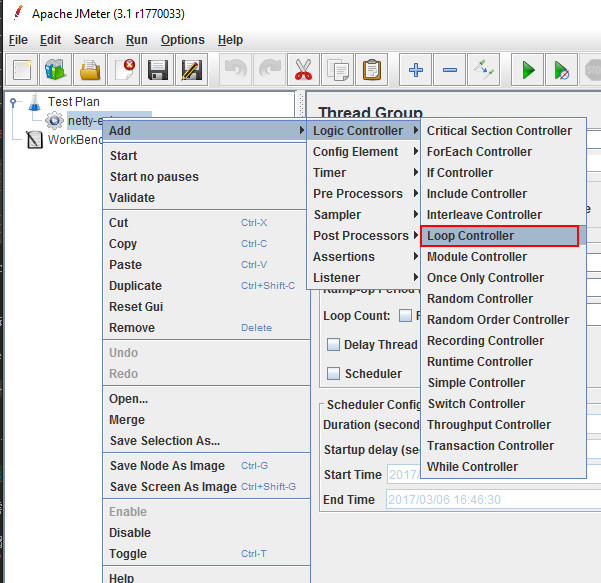
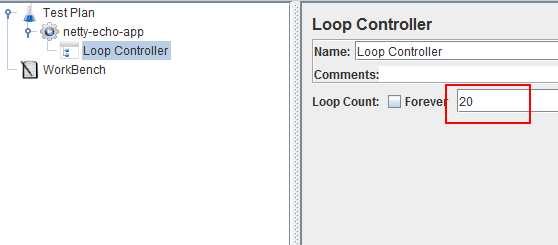
每个模拟用户发送20次请求
添加 ‘TCP Sampler’

填写正确的地址,端口和发送的内容,10代表\n
添加 Timer
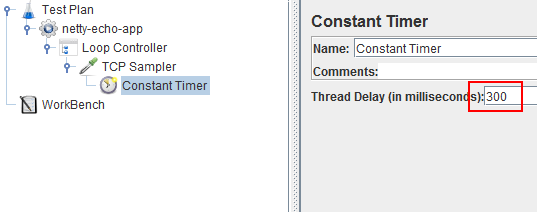
每间隔300ms发送一个请求。
添加 listener
添加Aggregate Report Listener监听结果。

运行并查看结果

总共发送了2000次请求,错误率为0,90% Line在1ms以下响应请求,注1ms并不是平均数。
此外,Jmeter还支持分布式测试。